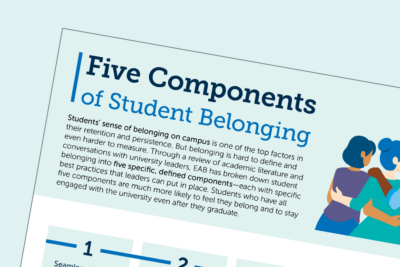Want to talk about racism with other education leaders? These are the important terms you need to know
When talking about the injustice, discrimination, and denial of opportunity against people of color, the language we use matters—referencing terms like diversity and inclusion is not the same as naming and addressing systemic racism. But understanding racism is complex, and for many, it is an emotionally vulnerable and challenging topic to discuss. Engaging in difficult, but absolutely critical, conversations about racism first requires a clear understanding of the key terms that compose this topic and the power of our language.
Read on to find straightforward definitions for terms you frequently come across in the media, literature, and conversations with others on the topic of racism. These terms are often used interchangeably, but each term used correctly brings a distinct meaning to the landscape of this work.
Use this guide to help you confidently lead dialogue across your institution and community and build a shared understanding of the change that is needed to create the anti-racist education institutions our society needs.
Racism and white privilege
- Racism (individual)—A person’s conscious and unconscious prejudice, hate, or bias against other people based on race
- Racism (systemic/structural)—The public policies, institutional practices, cultural messages, and social norms that are not practiced consciously, but reinforce and perpetuate racial group inequity
- White privilege—The unearned advantages, institutional preferential treatment, and exemption from racial oppression that white people have over other non-white groups
Key distinction
Racism does not only occur through individual beliefs and actions (e.g., one person being ignored or called a slur by someone else). Racism also occurs because of the default way that whole groups function—the preferred behaviors, the rules in place, or the way resources are managed. These deep-rooted practices lead to better outcomes for white people and worse outcomes for Black, Indigenous, and People of Color (BIPOC), and this can continue over time without any individual intent. Over time, the results of structural racism can strengthen individual racist beliefs and actions.
White privilege refers to the systematic advantage that white people have in accessing opportunities, power, and belonging as a result of systemic racism. White privilege does not suggest that white people have never struggled or that everything a white person has achieved is not deserved.
Equity and anti-racism
- Equity—Evaluating systems and institutions to identify and remove biases in the distribution of opportunities and resources
- Anti-racism—Identifying and challenging the structures, values, and behaviors that perpetuate systemic racism, and promoting racial equity for all people on an individual and systemic level
Key distinction
Equity work uncovers and then removes or corrects systematic obstacles that exist for certain groups and prevent them from reaching desired outcomes in an organization or society, while advantages are given to others. This work could address all kinds of obstacles (e.g., policies, access to resources) facing different groups that lead to worse outcomes based on income, age, gender, disability status, and more. Anti-racism is the process of specifically addressing the obstacles that are a result of our history of slavery, legalized segregation, racism, and policies designed to limit opportunities for BIPOC, in order to remove gaps in desired outcomes based on race.
Diversity, inclusion, and belonging
- Diversity—Representation of all the different characteristics that make one individual or group different from another
- Inclusion—Ensuring differences are welcomed, different perspectives are respectfully heard, and every individual feels a sense of belonging
- Belonging–A sense of fitting in or feeling like you are an important member of a group
Key distinction
Diversity is a fact—it looks at the number of people in a group of all different characteristics (e.g., age, income, race, ethnicity). Inclusion refers to intentional actions that enable people of all different characteristics to take part in that group actively and fully. Belonging is the emotional outcome of inclusion work, or the resulting sense of being a valued member of that group. It is hard to make significant and lasting changes to the diversity of a group without focusing on equity and inclusion.
Social justice and racial justice
- Social Justice—Equal access to wealth, opportunities, and privileges within a society
- Racial Justice—Systematic and proactive reinforcement of the public policies, institutional practices, cultural messages, and social norms needed to achieve and sustain racial equity
Key distinction
Social justice is the result of actions that broadly aim to share society’s burdens and benefits equally among all people. Racial justice is the result of sustained efforts specifically aimed at giving BIPOC equitable, or fair, access to power, opportunities, and resources (e.g., education, home ownership, health care, leadership roles) so that race no longer predicts desired outcomes in society.
Inclusive pedagogy and culturally responsive teaching
- Inclusive Pedagogy—A student-centered approach to teaching in which educators create an inviting and engaging learning environment for all students with varied backgrounds, learning styles, and physical and cognitive abilities
- Culturally Responsive Teaching—An approach to teaching that makes meaningful connections between what students learn in schools and their cultures, languages, and life experiences
Key distinction
Culturally responsive teaching is one way to make education more inclusive. Inclusive pedagogy looks at all aspects of learning—curricular materials, ways to engage in and contribute to the learning process, assessments used, and classroom dynamics—to ensure certain students are not prevented from participating as often or as easily as others for any reason (e.g., their gender, disability status, socioeconomic background, even personality traits like introversion). Culturally responsive teaching recognizes the specific importance of including students’ cultural references and assets (e.g., language, traditions, values) in all aspects of learning.
Bonus: What is critical race theory?
The critical race theory (CRT) movement officially organized in 1989. It examines racial power structures and suggests that racism impacts all aspects of our society, is seamlessly embedded in our policies, institutions, and social life, and that the individual racist does not need to exist for structural racism to be pervasive. At first, CRT was mainly referenced in legal scholarship but has since spread to many fields and disciplines.
More Resources

Create a Higher Ed Workplace Culture Where Faculty and Staff Want to Stay

5 components of student belonging
